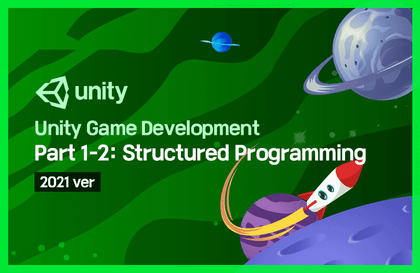
UnityのためのC#基礎プログラミング - 構造指向(無料)
UDevApp
UnityにはC#プログラミングが必要です。そして、C#プログラミングはオブジェクト指向と構造指向のプログラミングに分けられます。 この講義では、基礎C#プログラミング学習の基本的な内容を紹介しています。
입문
C#
You will understand the basic functionality and memory operations of Unity and learn how to create a game that runs a full cycle, not just a prototype.
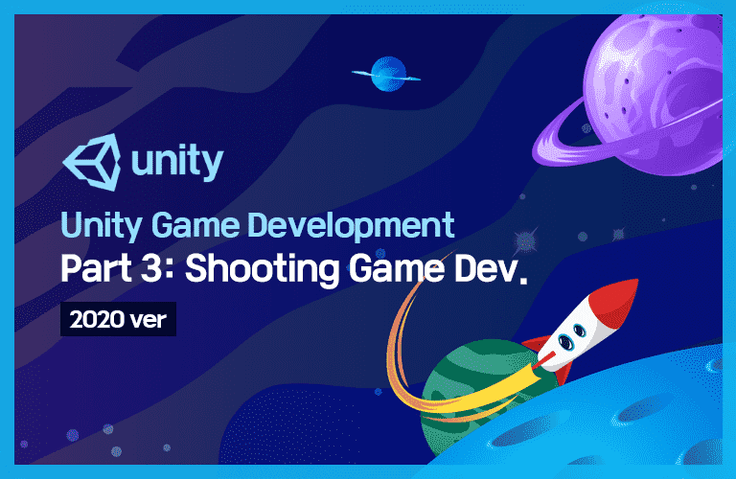
Memory structure of Unity actions
How to make a shooting game with Unity
How to make a real game, not a prototype
Game development for non-majors & beginners!
Let's understand the structure and principles of Unity + C# together.

After learning C# in Unity, I thought about what the most necessary course would be for beginners who want to make games. It is to know the internal functions of Unity and the relationship between the actual code and memory. Even if you make a cube or a character, if you don't know the actual internal memory operation, you can no longer make a game. You can only make a project where the ball bounces. I made this course to solve that problem.
So unlike other game courses, you learn Unity features and C# grammar while making a game with Unity. It doesn't just focus on using features. It explains how one feature internally relates to the code I'm making, and how actual classes, instances, and memory work between Unity features and my code. You can make games without having to use difficult grammar. Creating a character class that allows multiple inheritance of delegates or interfaces is something you should do after you've easily made and uploaded several games.
• How the memory of a game object in the hierarchy view exists
• Why connect objects by dragging?
• Why multiply a vector by Time.deltaTime?
• Why is there vector3 in game programming?
• Explains the principles and reasons why rigid bodies and colliders are separated.
In other lectures, these contents are explained for about a minute and then finished. That's because the lecture is for actual developers. However, non-majors and non-experts who are just starting out in game development need a different lecture. They need to understand why Unity has these features.
So, in this lecture, in addition to game production, more than half of the lecture is about understanding and practicing Unity's functions like C#. Games come after the middle part. This is because you can't write a program until you know the principles. Only actual developers can learn a lecture that only covers game development.
I created this course to teach non-majors and beginners how to create games.
This lecture is about how to approach game development from the perspective of non-majors and beginners. However, it is not easy. For example, in order to explain the principle of operation of game object variables in Monobehavior, it explains examples of possessive references, dereferences, and mutual references, and then explains the principle of operation of game object variables. If you see a small example with a similar structure, you may wonder why you should do this. However, programming is the work of understanding the internal principles of a computer and talking to a computer. As I said, in order for a computer to work, we need to go outside the class and know how the variables and functions that we can use work. It is the same as putting yourself in someone else's shoes in order to talk to someone else.
And that is what makes debugging possible. Programming is a struggle against hardship. You can make ridiculous and nonsensical errors. The basics are essential to solve these problems.
For beginners or novices, it will be impossible to understand this lecture if you do not know the basics of C# (corresponding to Part 2) . However, after learning this lecture and being able to create similar examples, the fear of creating an actual game will disappear.


The goal is to learn the grammar and develop an actual game by looking at the memory structure of Unity. It will be a simple shooting game, but we will work on uploading it to an actual store.
After taking this course, you will be able to develop a simple game. However, beginners should practice for at least 30 minutes a day. I think it will be a great help to beginners and non-majors who are approaching Unity.
The current course is short at about 8 hours, but there are nearly 100 lectures (more to come) .
If you study and practice briefly with short lectures, you can learn the basics of Unity C# programming in 30 days at the fastest and 3 months at the longest, with 30 minutes a day. However, non-majors are advised to learn slowly. Since programming is a language, you need to accumulate it in your long-term memory so that you can program yourself.

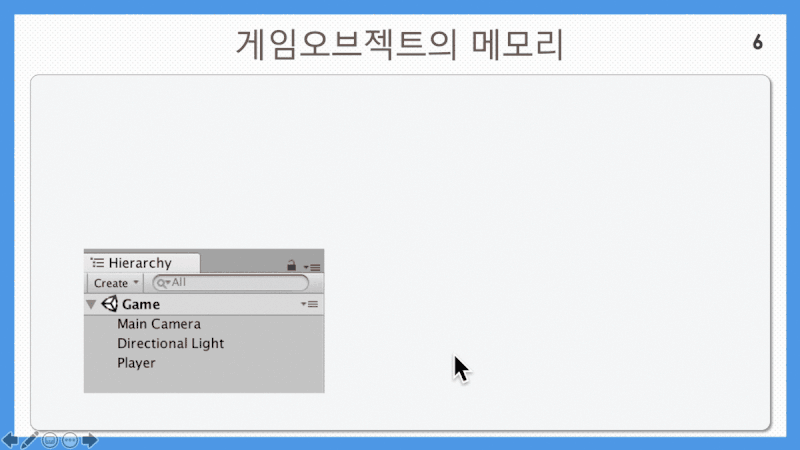
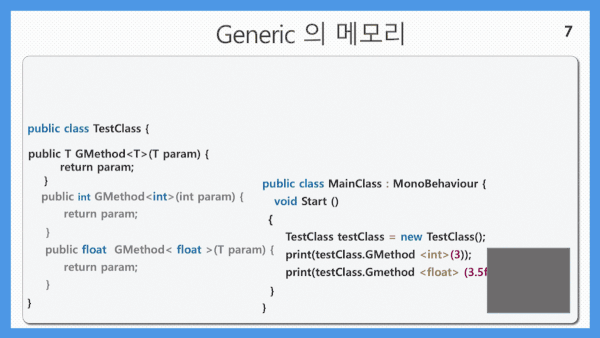
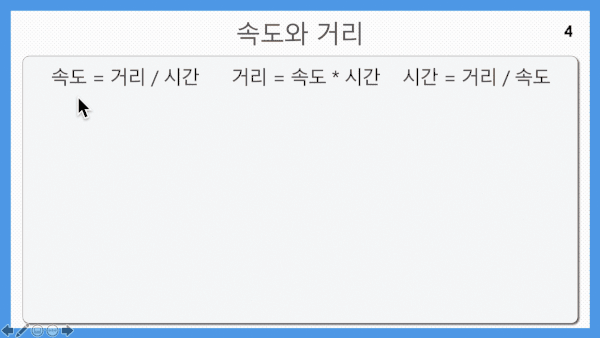
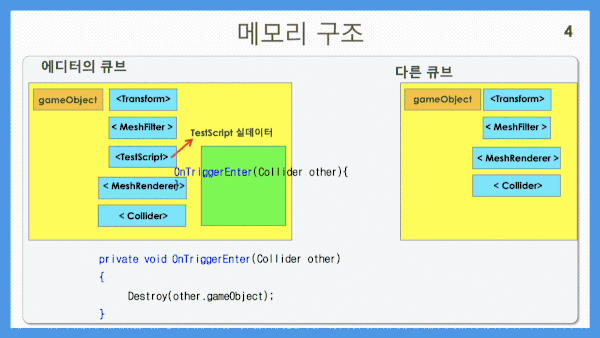

In this lecture, it is highly recommended that you study and practice. Especially, non-majors will never be able to learn programming just by watching since they do not normally work with programming.
After you understand it, you must practice it.
Q. Can non-majors also take the course?
A. Yes, this is a lecture for both non-majors and majors. However, non-majors and beginners must take the prerequisite course "C# Programming Course Part 2" on Inflearn to take this course. The C# review in Chapter 0 of this lecture is for majors.
Q. What are the benefits of learning “Shooting Game Development Course”?
A. You need to know the principles to apply them. You need to know the principles to apply them, not only when programming, but also when catching errors. When you make an error while programming, someone else won't solve the problem for you. If you actually make a game and run it through a cycle, you can do more things.
Q. What can I do after taking the “Shooting Game Development Course”?
A. You can stand at the starting point of making a game with Unity. It will also be a great help when making other programs with Unity. Since you can understand the principles, you can apply them. In other words, although it is a simple game, you can gain the ability to make a game. Also, it includes practical content such as making a game that can be uploaded and uploading it, so you can get practical tips necessary for smartphone game development.
Q. Are there any special advantages to this course?
A. It may be difficult at first. However, once you get past that stage and get to the middle or higher, you will have a concept of the principles. If you know the internal structure, you can predict how the computer works. Then, not only your programming skills but also your debugging skills will improve. Why are experienced people experienced? They are experienced because they are good at debugging. I will tell you the perspective of an experienced person who is good at debugging. Even if you complete 99%, if there is an error, the game is difficult to succeed. And if you can't solve the error, there is nothing more difficult than that. To prevent this situation, you need to study the principles and memory.
Who is this course right for?
Someone who has just started learning basic C#
If you are curious about how Unity objects work in memory
Need to know before starting?
C# Programming Language Related to Object-Oriented
C# Programming Part1
5,435
Learners
184
Reviews
151
Answers
4.9
Rating
4
Courses
안녕하세요. UDevApp 의 최형선이라고 합니다.
무엇인가를 만들어낸다는 것은 정말로 행복한 일입니다.
세상에 나의 제품이 나올 때의 느낌은 스티브잡스가 느낀 그것이나
여러분들이나 저와 다르지 않다고 생각합니다.
여러분들에게 그러한 감정을 드리는 사람이 되고 싶습니다.
네이버카페와 블로그와 유튜브에도 많이 찾아와 주시길 바랍니다.
.
https://cafe.naver.com/ultimategunz(카페바로가기)
http://blog.naver.com/siwoo2406(블로그 바로가기)
https://www.youtube.com/user/ChoiHyungSun/(유튜브 바로가기)
감사합니다.
All
230 lectures ∙ (30hr 21min)
Course Materials:
All
21 reviews
5.0
21 reviews
Reviews 3
∙
Average Rating 5.0
5
私は学校の先輩から推薦されて聞きました。 カリキュラムでは、セクションの整理がうまくいっていて、探したいものをすぐに聞くことができたのはとても良かったです。 私は音に少し敏感で、声はとても気にしていますが、聞いたことはありませんでした。 教科書で勉強したよりもずっと良いのが例をよく聞いて理解しやすかった C#ちょっと学んだら十分にやりそうで独学する人には投資するべきだ
良い受講評 ありがとうございます。非専攻者がアクセスしやすい講義です。 頑張って良い結果があってほしいです。 ^^
Reviews 1
∙
Average Rating 5.0
5
こんにちはハセヨン講師 最初は内容が休んでインターネットにある他の講義とは別の違いがないかと思ったのですが、少し過ぎてスクロールメニューに入ってデータロードしているのを見ると、ほぼ中級者向け講義になってしまいましたね。 私は講師が投稿した講義でUnityに初めて触れましたが、少し難しいですが、続けていくことはできると思います! これが完了したら、私もゲームをアップロードしたいです!
良い受講評 ありがとうございます。 早く次の講義をしてお会いしましょう^^
Reviews 4
∙
Average Rating 5.0
5
すべての講義のアップロードが完了したら、文章を残そうとしましたが、もう少し残っているようでレビューを残します。 私はプログラミングをこれで初めてアプローチしました。講義で言われたとおり、一日一時間ずつあるいは30分ずつを見続けて練習しました。こうして勉強してみると本当にいいですね 他のUnity講座とは異なる差別化された点があります。 ちょうどC#ではなく、C#に関連するUnityで使用されるC#の原理を学びます。 これは本当に役に立ちます。他の講義はそのまま従うように行われますが、 これは原則そのものを教えてくれるので本当に良いです。 なぜこのコードを今書かなければならないのか分かるので、自分で作るときにも大きな助けになるようです。 そしてキャラクターアップグレードされて選択して解禁する機能になっているんですよ。 別のゲームを作るときに大きな助けになりそうです。 早く全部完了して私もアップロードをしてみてほしいです。 次回も良い講義をお願いします。
よろしくお願いします。 毎日練習しましたね。生業があったという立場で、非専攻者が近づくにはこの方法しかないと思います。良い結果があることを願って、次の講義も早く作ってオープンします。ありがとうございます。 ^^
Reviews 4
∙
Average Rating 4.0
$59.40
Check out other courses by the instructor!
Explore other courses in the same field!